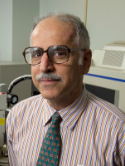Solution structure of the N-(deoxyguanosin-8-yl)-1-aminopyrene ([AP]dG) adduct opposite dA in a DNA duplex Journal Article
| Authors: | Gu, Z.; Gorin, A.; Krishnasamy, R.; Hingerty, B. E.; Basu, A. K.; Broyde, S.; Patel, D. J. |
| Article Title: | Solution structure of the N-(deoxyguanosin-8-yl)-1-aminopyrene ([AP]dG) adduct opposite dA in a DNA duplex |
| Abstract: | Solution structural studies have been undertaken on the aminopyrene-C8- dG ([AP]dG) adduct in the d(C5-[AP]G6-C7)·d(G16-A17-G18) sequence context in an 11-mer duplex with dA opposite [AP]dG, using proton-proton distance and intensity restraints derived from NMR data in combination with distance- restrained molecular mechanics and intensity-restrained relaxation matrix refinement calculations. The exchangeable and nonexchangeable protons of the aminopyrene and the nucleic acid were assigned following analysis of two- dimensional NMR data sets on the [AP]dG·dA 11-mer duplex in H2O and D2O solution. The broadening of several resonances within the d(G16-A17-G18) segment positioned opposite the [AP]dG6 lesion site resulted in weaker NOEs, involving these protons in the adduct duplex. Both proton and carbon NMR data are consistent with a syn glycosidic torsion angle for the [AP]dG6 residue in the adduct duplex. The aminopyrene ring of [AP]dG6 is intercalated into the DNA helix between intact Watson-Crick dC5·dG18 and dC7·dG16 base pairs and is in contact with dC5, dC7, dG16, dA17, and dG18 residues that form a hydrophobic pocket around it. The intercalated AP ring of [AP]dG6 stacks over the purine ring of dG16 and, to a lesser extent dG18, while the looped out deoxyguanosine ring of [AP]dG6 stacks over dC5 in the solution structure of the adduct duplex. The dA17 base opposite the adduct site is not looped out of the helix but rather participates in an in-plane platform with adjacent dG18 in some of the refined structures of the adduct duplex. The solution structures are quite different for the [AP]dG·dA 11-mer duplex containing the larger aminopyrene ring (reported in this study) relative to the previously published [AF]dG·dA 11-mer duplex containing the smaller aminofluorene ring (Norman et al., Biochemistry 28, 7462-7476, 1989) in the same sequence context. Both the modified syn guanine and the dA positioned opposite it are stacked into the helix with the aminofluorene chromophore displaced into the minor groove in the latter adduct duplex. By contrast, the aminopyrenyl ring participates in an intercalated base-displaced structure in the present study of the [AP]dG·dA 11-mer duplex and in a previously published study of the [AP]dG·dC 11-mer duplex (Mao et al., Biochemistry 35, 12659-12670, 1996). Such intercalated base-displaced structures without hydrogen bonding between the [AP]dG adduct and dC or mismatched dA residues positioned opposite it, if present at a replication fork, may cause polymerase stalling and formation of a slipped intermediate that could produce frameshift mutations, the most dominant mutagenic consequence of the [AP]dG lesion. |
| Keywords: | controlled study; frameshift mutation; guanine; deoxyguanosine; base pairing; dna adduct; hydrogen bond; dna adducts; protons; solutions; crystallography, x-ray; chemical structure; molecular interaction; water; dna helix; carcinogens, environmental; proton nuclear magnetic resonance; chemical bond; carbon; proton; calculation; nucleic acid; phosphorus; carbon nuclear magnetic resonance; chromatophore; nuclear magnetic resonance, biomolecular; intercalation complex; nucleic acid heteroduplexes; deuterium oxide; priority journal; article; dna hybrid; pyrenes; deoxyguanosine derivative; fluorene derivative; pyrene derivative; 2-acetylaminofluorene; gymnomyza samoensis |
| Journal Title: | Biochemistry |
| Volume: | 38 |
| Issue: | 33 |
| ISSN: | 0006-2960 |
| Publisher: | American Chemical Society |
| Date Published: | 1999-08-17 |
| Start Page: | 10843 |
| End Page: | 10854 |
| Language: | English |
| DOI: | 10.1021/bi9912138 |
| PUBMED: | 10451381 |
| PROVIDER: | scopus |
| DOI/URL: | |
| Notes: | Article -- Export Date: 16 August 2016 -- Source: Scopus |
Altmetric
Citation Impact
BMJ Impact Analytics
Related MSK Work




